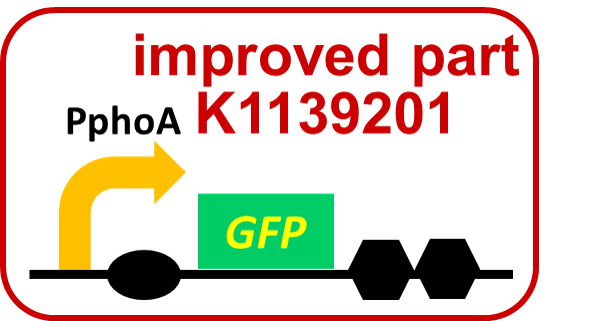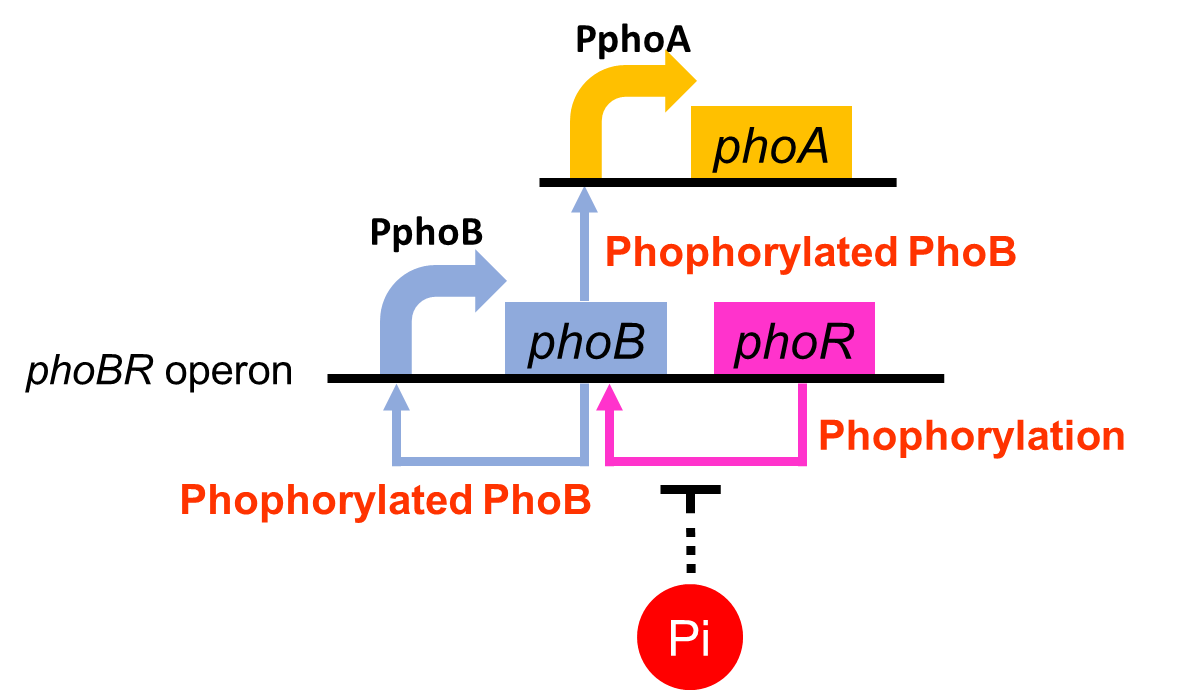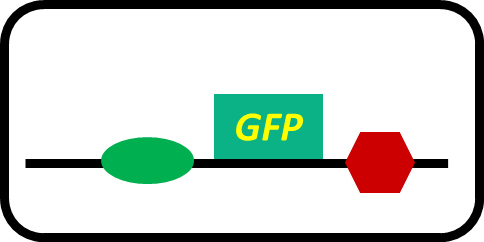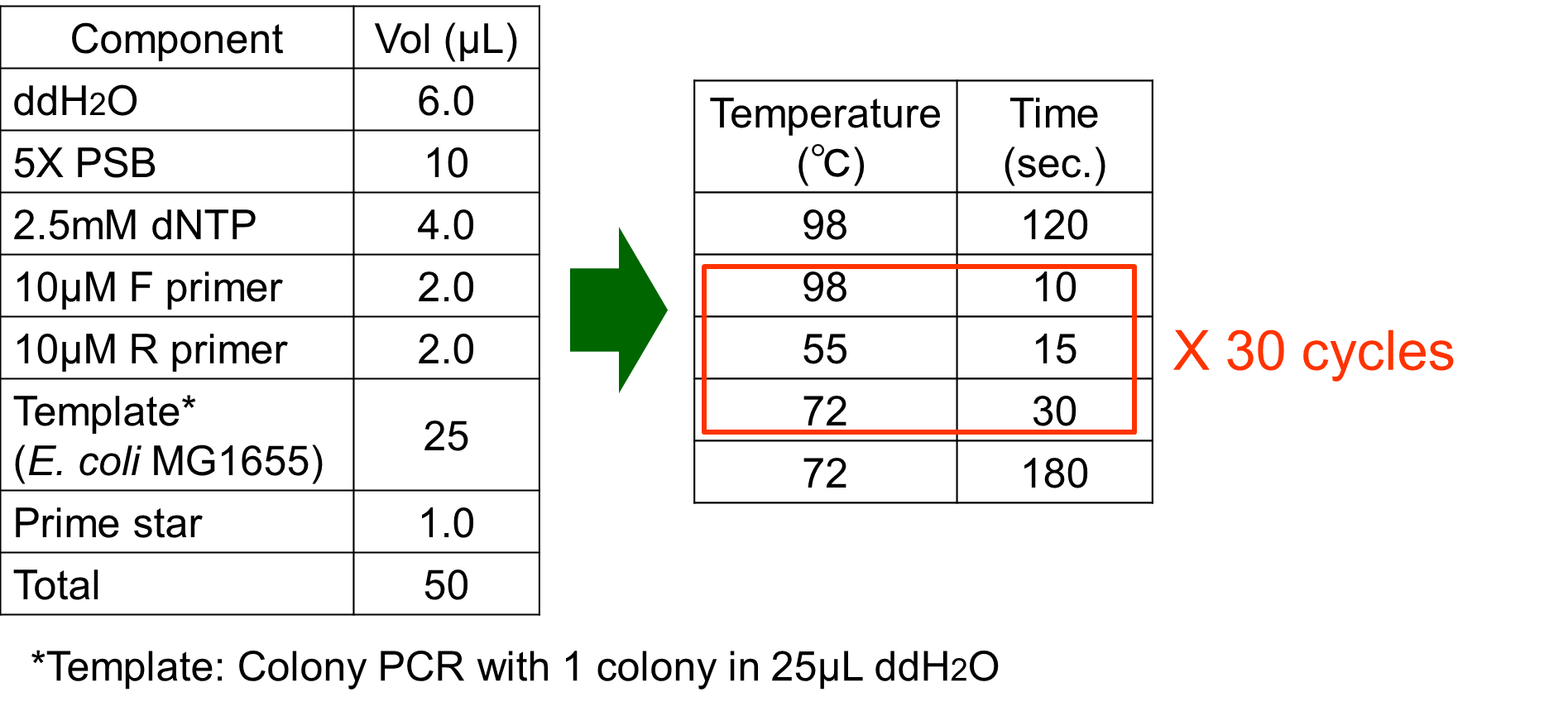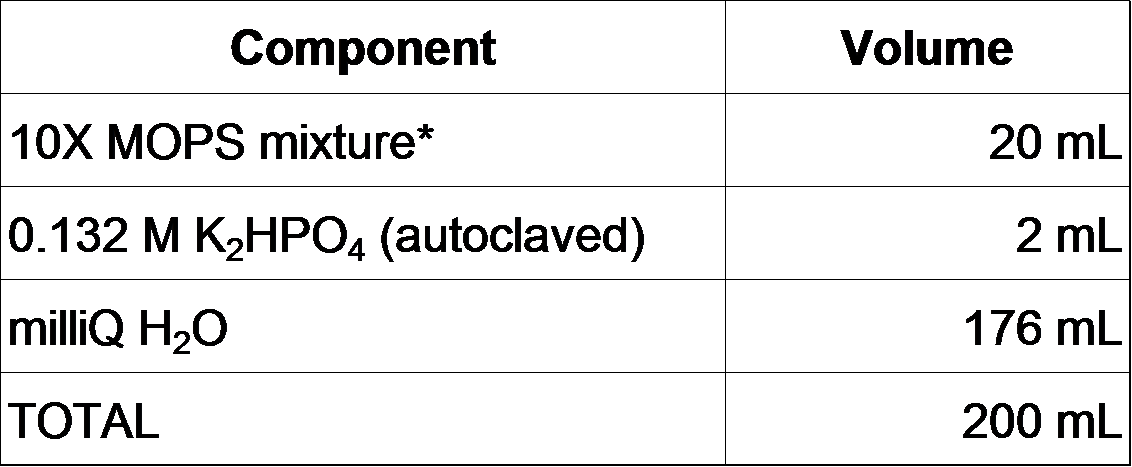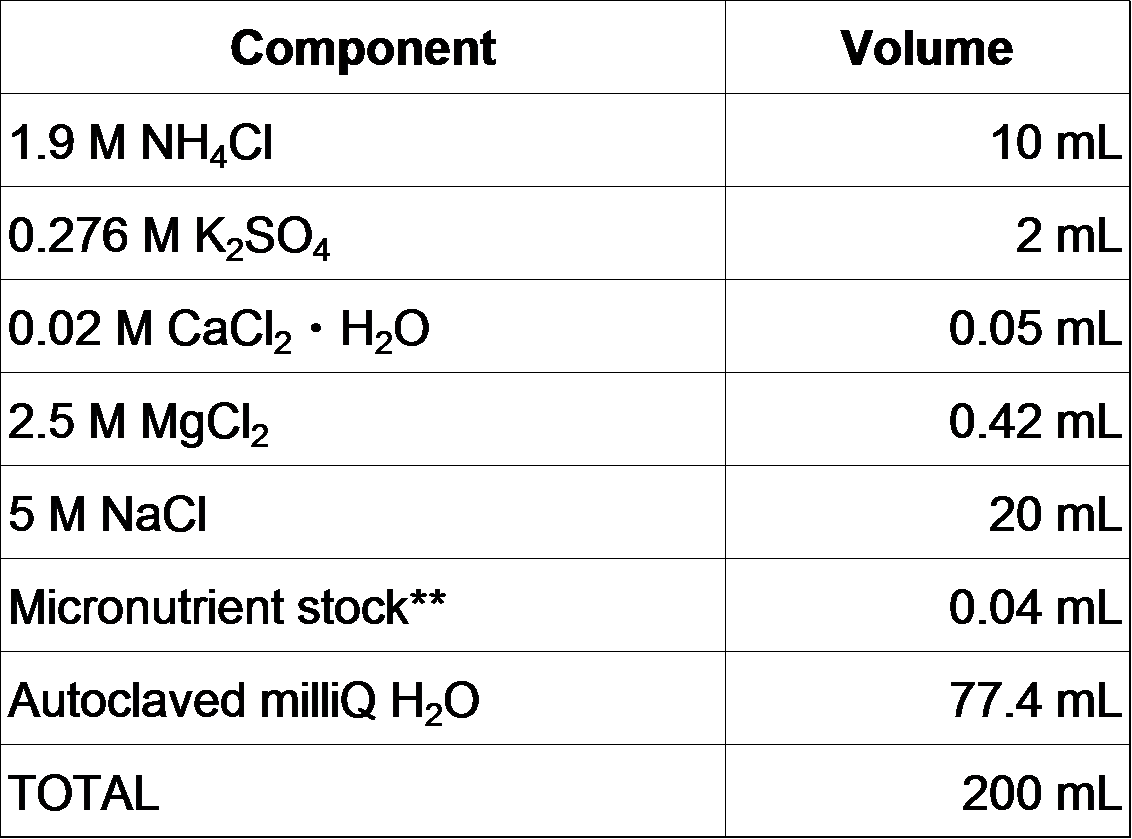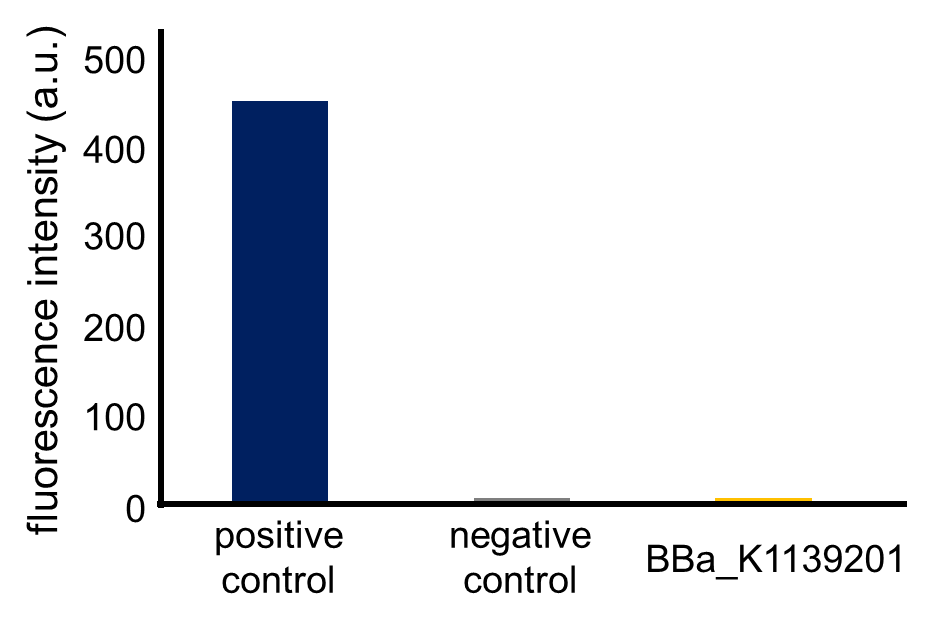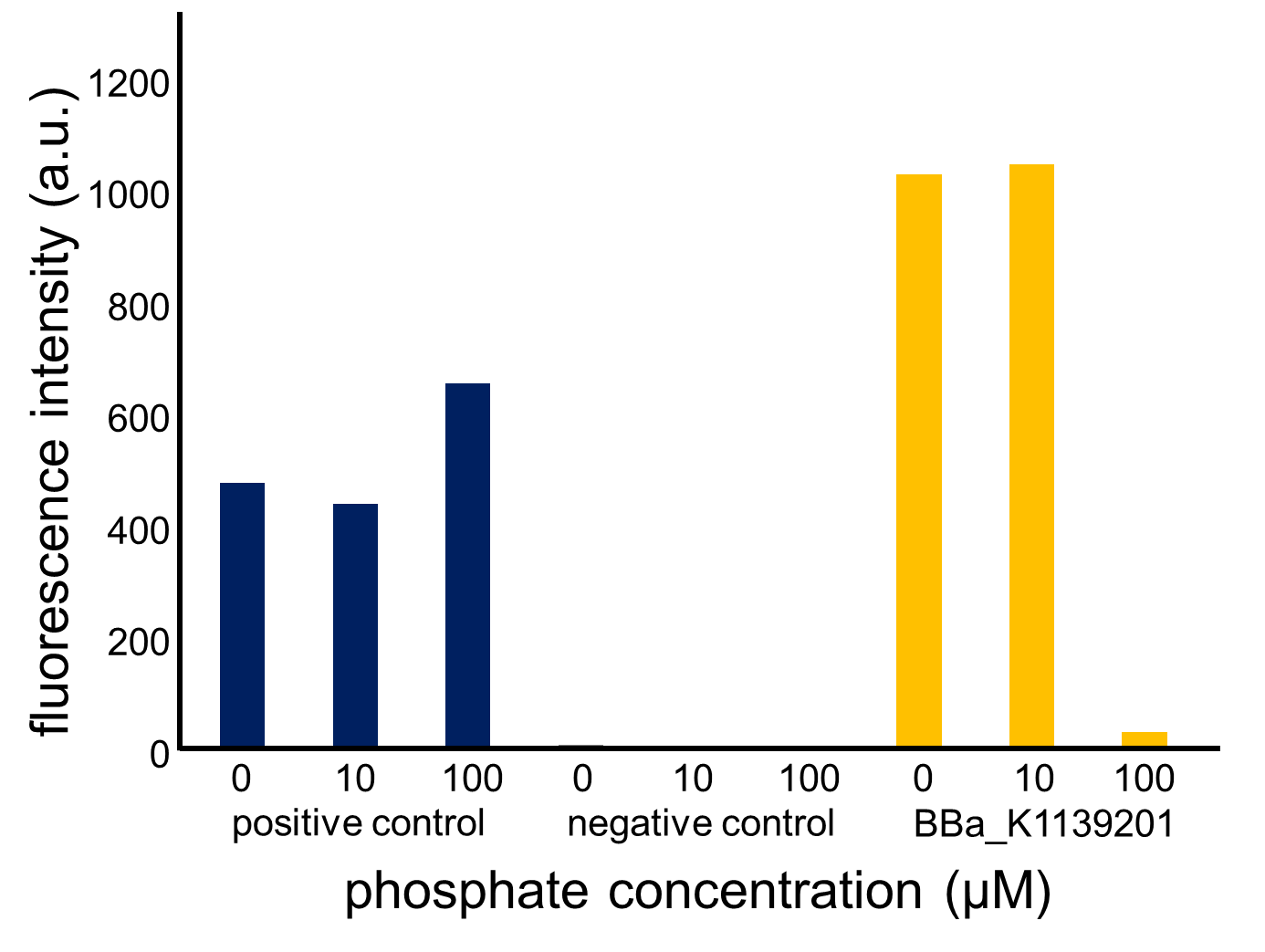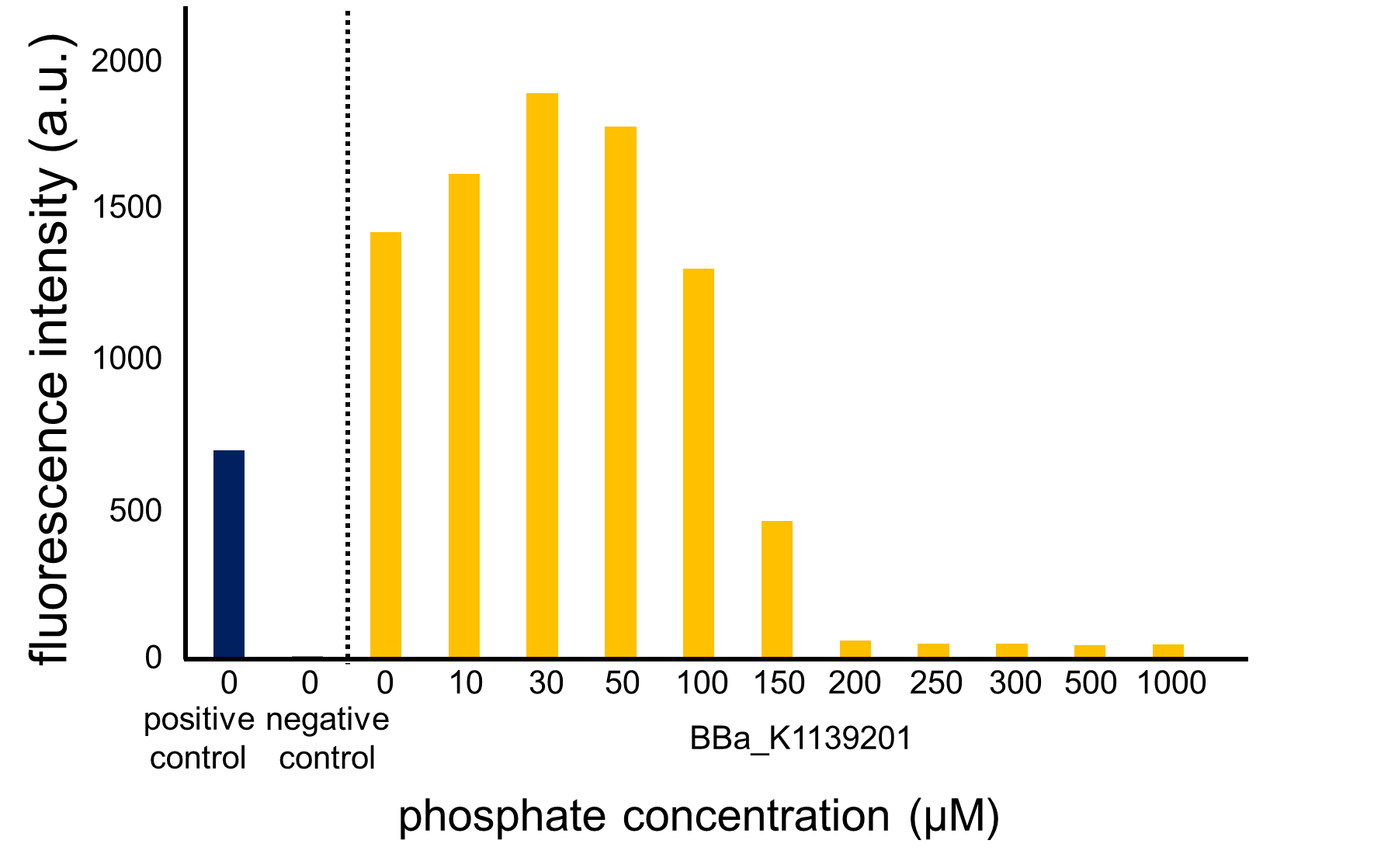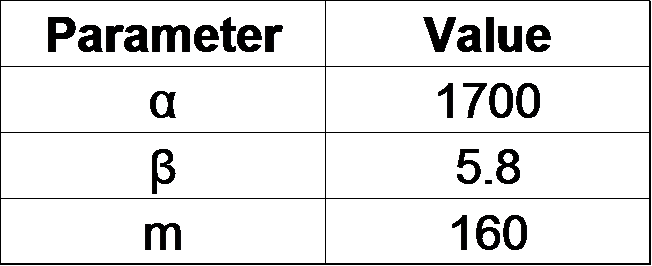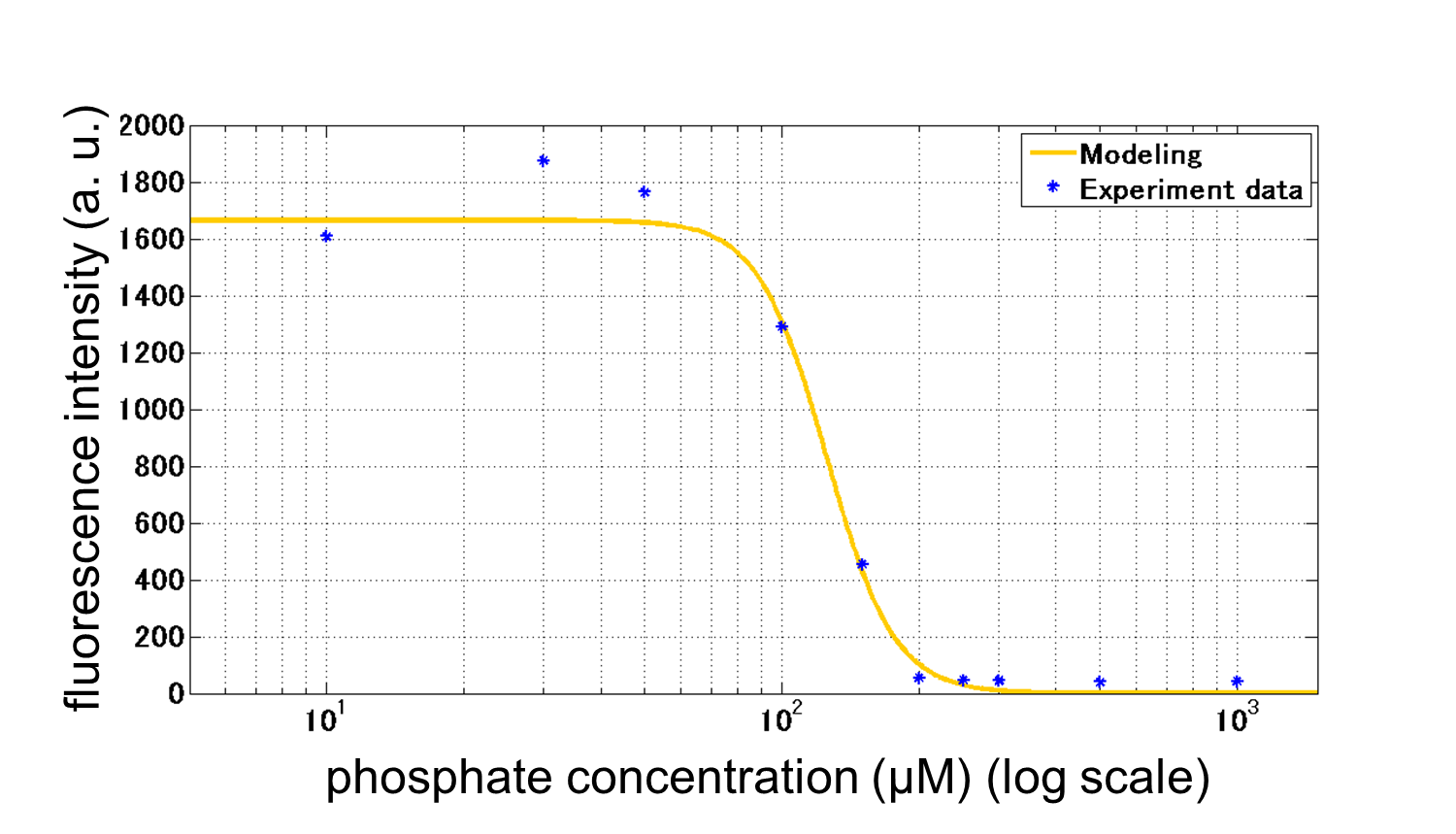Team:Tokyo Tech/Experiment/phoA Promoter Assay
From 2013.igem.org
| Line 110: | Line 110: | ||
<p>3-2. After inducing by phosphate concentration | <p>3-2. After inducing by phosphate concentration | ||
</p> | </p> | ||
| - | <p>Fig. 3-5-13 | + | <p>Fig. 3-5-13 and 14 show the fluorescence intensity of the induced cells by phosphate concentration. In Fig. 3-5-13, we saw that <i>phoA</i> promoter was repressed by the high phosphate concentration, while constitutive promoter did not have such significant change. The result shown in Fig. 3-5-14 also proved that the increase in phosphate concentration repressed the <i>phoA(/i> promoter. Fig. 3-5-15 shows the picture of fluorescence of the induced cells. Especially, we confirmed that the <i>phoA</i> promoter was drastically repressed at phosphate concentrations of 100 to 300 microM. |
</p> | </p> | ||
| - | [[Image:Titech2013_phoa_Fig_3-5-13.png|450px|thumb|center|Fig. 3-5-13. Fluorescence intensity of the induced cells]]<br> | + | [[Image:Titech2013_phoa_Fig_3-5-13.png|450px|thumb|center|Fig. 3-5-13. Fluorescence intensity of the induced cells (with positive and negative controls)]]<br> |
| - | [[Image:Titech2013_phoa_Fig_3-5- | + | [[Image:Titech2013_phoa_Fig_3-5-15.png|450px|thumb|center|Fig. 3-5-14. Fluorescence intensity of the induced cells of BBa_ K1139201]]<br> |
| + | [[Image:Titech2013_phoa_Fig_3-5-14.png|450px|thumb|center|Fig. 3-5-15. Picture of fluorescence of the induced cells]] | ||
</h2> | </h2> | ||
<h1>4. Discussion</h1> | <h1>4. Discussion</h1> | ||
<h2> | <h2> | ||
| - | <p>We confirmed that the increase in phosphate concentration repressed the <i>phoA</i> promoter. Compared to OUC-China’s phosphate sensor part including <i>phoB</i> promoter (Fig. 3-5- | + | <p>We confirmed that the increase in phosphate concentration repressed the <i>phoA</i> promoter. Compared to OUC-China’s phosphate sensor part including <i>phoB</i> promoter (Fig. 3-5-17), our phosphate sensor part shows clearer result (Fig. 3-5-16). |
</p> | </p> | ||
<gallery widths="400px" heights="250px" style="margin-left: auto; mergin-right: auto; text-align:center;"> | <gallery widths="400px" heights="250px" style="margin-left: auto; mergin-right: auto; text-align:center;"> | ||
| - | Image:Titech2013_phoa_Fig_3-5-15.png|Fig. 3-5- | + | Image:Titech2013_phoa_Fig_3-5-15.png|Fig. 3-5-16. Our <i>phoA</i> promoter assay result]] |
| - | Image:Titech2013_phoa_Fig_3-5-16.png|Fig. 3-5- | + | Image:Titech2013_phoa_Fig_3-5-16.png|Fig. 3-5-17. OUC-China 2012’s <i>phoB</i> promoter assay result (converted to bar chart)]] |
</gallery> | </gallery> | ||
</h2> | </h2> | ||
<h1>5. Modeling </h1> | <h1>5. Modeling </h1> | ||
<h2> | <h2> | ||
| - | <p>From our results explained above, we determined parameters for the induction mechanism. By fitting the results to the following Hill equation (Fig. 3-5- | + | <p>From our results explained above, we determined parameters for the induction mechanism. By fitting the results to the following Hill equation (Fig. 3-5-18), we identified m and the hill coefficient. Those parameters (Fig. 3-5-19) will be used in our future modeling. Plants are reported to be in phosphate starvation under the concentration of 1 mM (D. Hoagland et al., 1950). Our part can also sense the concentration below 1 mM (Fig. 3-5-20). Therefore, our improved part is useful for our farming circuit. We also identified maximum GFP production rate in this construct. |
</p> | </p> | ||
<gallery widths="350" style="margin-left:auto; margin-right:auto;"> | <gallery widths="350" style="margin-left:auto; margin-right:auto;"> | ||
| - | Image:Titech2013_phoa_Fig_3-5-17.png|Fig. 3-5- | + | Image:Titech2013_phoa_Fig_3-5-17.png|Fig. 3-5-18. Equation for the induction mechanism |
| - | Image:Titech2013_phoa_Fig_3-5-18.png|Fig. 3-5- | + | Image:Titech2013_phoa_Fig_3-5-18.png|Fig. 3-5-19. Determined parameters |
</gallery> | </gallery> | ||
| - | [[Image:Titech2013_phoa_Fig_3-5-19.png|450px|thumb|center|Fig. 3-5- | + | [[Image:Titech2013_phoa_Fig_3-5-19.png|450px|thumb|center|Fig. 3-5-20. A model with fitting the results of our assay]] |
</h2> | </h2> | ||
<h1>6. Reference</h1> | <h1>6. Reference</h1> | ||
Revision as of 06:23, 27 September 2013
phoA Promoter Assay
Contents |
1. Introduction
To realize our farming project, we improved a phosphate sensor part ([http://parts.igem.org/Part:BBa_K1139201 BBa_ K1139201], Fig. 3-5-1) since the existing phosphate sensor part (OUC-China 2012, [http://parts.igem.org/Part:BBa_K116401 BBa_K116401]) does not have sufficient data. Our part includes the inducible promoter of the alkaline phosphatase gene (phoA) derived from E.coli (M. Dollard et al., 2003). The phoA promoter is repressed by high concentration phosphate. A brief system of the phoA promoter is shown in Fig. 3-5-2. The phoA gene is regulated by phoB and phoR, which belong to pho regulon (H. Shinagawa et al., 1983). Phosphorylated PhoB activates the expression of phoA. Under conditions of phosphate limitation, PhoR phosphorylates PhoB. On the other hand, under conditions of high phosphate concentrations, PhoR dephosphorylate phospho-PhoB (Y. Hsieh et al., 2010). We amplified the phoA promoter from E. coli (MG1655). We ligated this promoter upstream of GFP part and introduced this part into E.coli (MG1655). By following induction assay, we confirmed that the phoA promoter was actually repressed by the increase in phosphate concentration
2. Materials and Methods
2-1. Construction
-pSB6A1-PphoA-GFP (MG1655)…BBa_K1139201
-pSB6A1-Ptet-GFP (MG1655)… positive control
-pSB6A1-promoterless-GFP (MG1655)… negative control
The phoA promoter region of E. coli was amplified from MG1655 genomic DNA by PCR using upstream primer (5’-acgtgaattcgcggccgcttctagagaaagttaatcttttcaacagctgtcataaag-3’) and downstream primer (5’ccgctactagtaaatacattaaaaaataaaaacaaagcgactataagtctc-3’). Amplification was carried out with the steps shown in Fig. 3-5-6.
-pSB6A1-PphoA-GFP (MG1655)…BBa_K1139201
-pSB6A1-Ptet-GFP (MG1655)… positive control
-pSB6A1-promoterless-GFP (MG1655)… negative control
The phoA promoter region of E. coli was amplified from MG1655 genomic DNA by PCR using upstream primer (5’-acgtgaattcgcggccgcttctagagaaagttaatcttttcaacagctgtcataaag-3’) and downstream primer (5’ccgctactagtaaatacattaaaaaataaaaacaaagcgactataagtctc-3’). Amplification was carried out with the steps shown in Fig. 3-5-6.
2-2. Assay Protocol
2-2-0. Prepare MOPS minimal medium as follows (F. Neidhardt et al., 1974).
Also, prepare a series of phosphate concentration gradient 1 X MOPS by changing the volume of K2HPO4 (We prepared the series as 0, 10, 30, 100, 300, 1000 microM).
[Prepare MOPS minimal medium]
200 mL of 1 X MOPS is prepared as follows.
1. Mix ingredients above and adjust the pH to 7.2 with 5 M NaOH.
2. Filter sterilize. It can be stored at 4°C for up to 1 month.
3. Before use, add carbon source (we used a final concentration of 0.1% glucose).
*10 X MOPS mixture (200 mL)
1. Add the following to ~60 mL milliQ H2O:
2. Add 5 M KOH to a final pH of 7.4.
3. Bring total volume to 88 mL.
4. Make fresh FeSO4 solution and add it to the MOPS/Tricine solution:
5. Add the following solutions to the MOPS/Tricine/FeSO4 solution.
(Mix in the order shown)
6. Filter sterilize with 0.2 micron filter.
7. Aliquot into sterile plastic bottle and freeze at -20°C.
**Micronutrient stock (50 mL)
Mix everything together in 40 mL autoclaved milliQ H2O, bring up total volume to 50 mL.
Store at room temperature.
2-2-1. Prepare overnight culture of BBa_K1139201, positive control and negative control, each in MOPS medium (including 1.32 mM K2HPO4) containing ampicillin (50 microg/mL) at 37°C.
2-2-2. Dilute the overnight cultures to an OD600 of 0.1 in fresh MOPS medium (3 mL) containing ampicillin (50 microg/mL). (→fresh cultures)
2-2-3. Incubate the fresh cultures until the observed OD600 reaches 0.4-0.6.
2-2-4. Centrifuge the cells at 6000g, 25°C, 10 minutes, wash twice with MOPS minimal medium without phosphate containing ampicillin (50 microg/mL), and then suspend in the same medium to obtain a final OD600 of 10.
2-2-5. Add 300 microL of prepared cell suspension to 2.7 mL of test solution, the series of phosphate concentration gradient 1 X MOPS, containing ampicillin (50 microg/mL).
2-2-6. Incubate the cells for 140 minutes at 26°C.
2-2-7. 1 mL of each culture was harvested by centrifugation and suspended by adding 1 mL of PBS (phosphate-buffered saline). Dilute the suspension to obtain a final OD600 of around 0.2 by PBS.
2-2-8. Dispense 600 microL of each suspension into a disposable tube through a cell strainer. Fluorescence intensity was measured with a flow cytometer of Becton, Dickinson and Company.
2-2-0. Prepare MOPS minimal medium as follows (F. Neidhardt et al., 1974).
Also, prepare a series of phosphate concentration gradient 1 X MOPS by changing the volume of K2HPO4 (We prepared the series as 0, 10, 30, 100, 300, 1000 microM).
[Prepare MOPS minimal medium]
200 mL of 1 X MOPS is prepared as follows.
1. Mix ingredients above and adjust the pH to 7.2 with 5 M NaOH.
2. Filter sterilize. It can be stored at 4°C for up to 1 month.
3. Before use, add carbon source (we used a final concentration of 0.1% glucose).
*10 X MOPS mixture (200 mL)
1. Add the following to ~60 mL milliQ H2O:
2. Add 5 M KOH to a final pH of 7.4.
3. Bring total volume to 88 mL.
4. Make fresh FeSO4 solution and add it to the MOPS/Tricine solution:
5. Add the following solutions to the MOPS/Tricine/FeSO4 solution. (Mix in the order shown)
6. Filter sterilize with 0.2 micron filter.
7. Aliquot into sterile plastic bottle and freeze at -20°C.
**Micronutrient stock (50 mL)
Mix everything together in 40 mL autoclaved milliQ H2O, bring up total volume to 50 mL. Store at room temperature.
2-2-1. Prepare overnight culture of BBa_K1139201, positive control and negative control, each in MOPS medium (including 1.32 mM K2HPO4) containing ampicillin (50 microg/mL) at 37°C.
2-2-2. Dilute the overnight cultures to an OD600 of 0.1 in fresh MOPS medium (3 mL) containing ampicillin (50 microg/mL). (→fresh cultures)
2-2-3. Incubate the fresh cultures until the observed OD600 reaches 0.4-0.6.
2-2-4. Centrifuge the cells at 6000g, 25°C, 10 minutes, wash twice with MOPS minimal medium without phosphate containing ampicillin (50 microg/mL), and then suspend in the same medium to obtain a final OD600 of 10.
2-2-5. Add 300 microL of prepared cell suspension to 2.7 mL of test solution, the series of phosphate concentration gradient 1 X MOPS, containing ampicillin (50 microg/mL).
2-2-6. Incubate the cells for 140 minutes at 26°C.
2-2-7. 1 mL of each culture was harvested by centrifugation and suspended by adding 1 mL of PBS (phosphate-buffered saline). Dilute the suspension to obtain a final OD600 of around 0.2 by PBS.
2-2-8. Dispense 600 microL of each suspension into a disposable tube through a cell strainer. Fluorescence intensity was measured with a flow cytometer of Becton, Dickinson and Company.
3. Results
3-1. Before inducing by phosphate concentration
Fig. 3-5-12 shows the fluorescence intensity of the fresh cultures (the MOPS medium which contains 1.32 mM K2HPO4) incubated until the observed OD600 reached 0.4-0.6 (Assay protocol 2-2-3). The phoA promoter was repressed because the MOPS medium contained 1.32 mM phosphate, which was a high concentration for phoA promoter.
3-2. After inducing by phosphate concentration
Fig. 3-5-13 and 14 show the fluorescence intensity of the induced cells by phosphate concentration. In Fig. 3-5-13, we saw that phoA promoter was repressed by the high phosphate concentration, while constitutive promoter did not have such significant change. The result shown in Fig. 3-5-14 also proved that the increase in phosphate concentration repressed the phoA(/i> promoter. Fig. 3-5-15 shows the picture of fluorescence of the induced cells. Especially, we confirmed that the <i>phoA promoter was drastically repressed at phosphate concentrations of 100 to 300 microM.
4. Discussion
We confirmed that the increase in phosphate concentration repressed the phoA promoter. Compared to OUC-China’s phosphate sensor part including phoB promoter (Fig. 3-5-17), our phosphate sensor part shows clearer result (Fig. 3-5-16).
5. Modeling
From our results explained above, we determined parameters for the induction mechanism. By fitting the results to the following Hill equation (Fig. 3-5-18), we identified m and the hill coefficient. Those parameters (Fig. 3-5-19) will be used in our future modeling. Plants are reported to be in phosphate starvation under the concentration of 1 mM (D. Hoagland et al., 1950). Our part can also sense the concentration below 1 mM (Fig. 3-5-20). Therefore, our improved part is useful for our farming circuit. We also identified maximum GFP production rate in this construct.
 "
"


